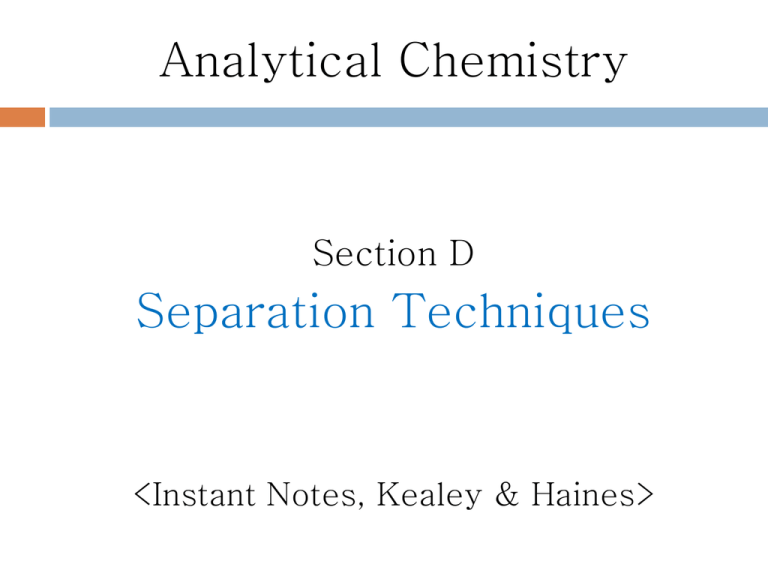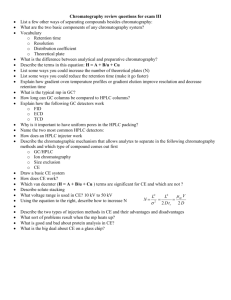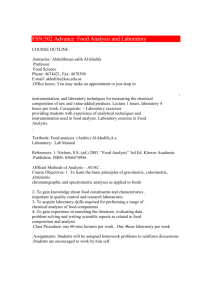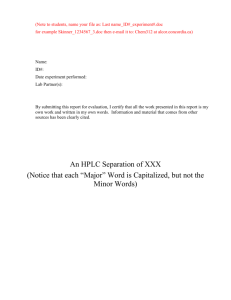HPLC
advertisement

Analytical Chemistry Section D Separation Techniques <Instant Notes, Kealey & Haines> Contents 6. High-Performance Liquid Chromatography: Principles and Instrumentation 7. High-Performance Liquid Chromatography: Modes, Procedures and Applications 8. Electrophoresis and Electrochromatography: Principles and Instrumentation 9. Electrophoresis and Electrochromatography: Procedures and Applications 6. High-Performance Liquid chromatography : Principles and Instrumentation Principles High-performance liquid chromatography(HPLC) is a technique for the separation of components of mixtures by differential migration through a column containing a microparticulate solid stationary phase. Solutes are transported through the column by a pressurized flow of liquid mobile phase, and detected as they are eluted. Mobile Phase The mobile phase is either a single solvent or blend of two or more having the appropriate eluting power for the sample components. It ranges from a nonpolar liquid to aqueousbuffers mixed with an organic solvent. Solvent Delivery system The solvent delivery system comprises a means of degassing, filtering and blending up to four solvents which are them delivered to the top of the column under pressure by a constant flow pump. 6. High-Performance Liquid chromatography : Principles and Instrumentation Sample Injection Liquid samples or solutions are introduced into the flowing mobile phase at the top of the column through a constant or variable volume loop and valve injector that is loaded with a syringe. Column and Stationary Phase Columns are straight lengths of stainless steel tubing tightly packed with a microparticulate stationary phase. The column packings are chemically modified silicas, unmodified silica or polymeric resins or gels. Solute Detection Solutes are detected in the mobile phase as they are eluted from the end of column. The detector generates an electrical signal that can be amplified and presented in the form of a chromatogram of solute concentration as a function of time. Instrument Control and Data Processing A dedicated microcomputer is an integral part of a modern High-performance chromatograph. Software packages facilitate the control and monitoring of instrumental parameters, and the display and processing of data. 6. High-Performance Liquid chromatography : Principles and Instrumentation Principle(1) - The elution order is depending on the chemical nature of the solutes and the overall polarity of the two phases. - Very small particles of stationary phase are essential for separation efficiency and resolution. 6. High-Performance Liquid chromatography : Principles and Instrumentation Principle(2) Solvent Delivery System Sample Injection Valve Detection and Recording System Column Microcomputer with Control and DataProcessing Software Fig. 1. Schematic diagram of a high-performance liquid chromatograph 6. High-Performance Liquid chromatography : Principles and Instrumentation Mobile Phase(1) - Unlike a GC carrier gas, Mobile phase influence retention and selectivity. - The composition of mobile phase is crucial in both respects. → For normal-phase separation (Stationary Phase more polar than Mobile Phase.) → For reversed-phase separation (Stationary Phase less Polar than Mobile Phase.) 6. High-Performance Liquid chromatography : Principles and Instrumentation Mobile Phase(2) - Elution can be under isocratic conditions or a composition gradient. → Isocratic condition is constant mobile phase condition. → Gradient can be generated to improve the resolution of complex mixtures. 6. High-Performance Liquid chromatography : Principles and Instrumentation Solvent Delivery System - Solvent Reservoirs It removes dust and other particulate material. - De-gassing It prevents air interfere with detector response by bubbles. - Gradient Former It generates binary, ternary or quaternary mixtures of solvents. 6. High-Performance Liquid chromatography : Principles and Instrumentation Sample Injection(1) - The loop is filled or partially filled with sample from a syringe. - Disposable guard column → It is positioned between the injector and the analytical column. → It can protect the analytical column from particulate matter and retained matrix components from injected samples. 6. High-Performance Liquid chromatography : Principles and Instrumentation Sample Injection(2) Fig. 2. Sample-injection valve and loop (a) Sample-loading position (b) Sample-injection position 6. High-Performance Liquid chromatography : Principles and Instrumentation Column(1) - The column is where the separation is occurred. - There are two types of HPLC column. → Conventional column → Microbore column 6. High-Performance Liquid chromatography : Principles and Instrumentation Column(2) Conventional/Microbore column - The two kinds of columns are basically same. - Microbore column has low flow rate, higher operating pressures and smaller internal diameter . - Being more sensitive and efficient, the microbore column has better than conventional column. 6. High-Performance Liquid chromatography : Principles and Instrumentation Column(3) 6. High-Performance Liquid chromatography : Principles and Instrumentation Stationary Phase - Octadecyl silica(ODS or C18) is the most widely used of all the stationary phases. → Octyl and shorter alkyl chains are more suitable for polar solutes. - Size exclusion and ion-exchange stationary phases are based either silica or polymer. 6. High-Performance Liquid chromatography : Principles and Instrumentation Solute Detection(1) - Detector is several type ① UV-visible absorbance detector a. Fixed-wavelength filter-photometer b. variable-wavelength spectrophotometer c. Photodiode-array detector ② Fluorescence detector ③ Refractive index ④ Electrochemical detector 6. High-Performance Liquid chromatography : Principles and Instrumentation Solute Detection(2) - UV-visible absorbance detector Fixed-wavelength filter-photometer ① This is the simplest detector. ② It has limited number of wavelength. ③ It has limited use. 6. High-Performance Liquid chromatography : Principles and Instrumentation Solute Detection(3) - UV-visible absorbance detector variable-wavelength spectrophotometer ① This is much more versatile. ② The detector allows monitoring at any wavelength within the working range of the detector. 6. High-Performance Liquid chromatography : Principles and Instrumentation Solute Detection(4) Fig. 3. UV-visible variable-wavelength spectrophotometric detector 6. High-Performance Liquid chromatography : Principles and Instrumentation Solute Detection(5) - UV-visible absorbance detector Photodiode-array detector ① The spectra and the developing chromatogram at any wavelength can be displayed on VDU screen in real time. ② The data comparisons made with library spectra for identification purpose. 6. High-Performance Liquid chromatography : Principles and Instrumentation Solute Detection(6) Fig. 4. Diode-array detector 6. High-Performance Liquid chromatography : Principles and Instrumentation Solute Detection(7) Fig. 5. 3-D display mode for a diode-array detector 6. High-Performance Liquid chromatography : Principles and Instrumentation Solute Detection(8) Fluorescence detector - The detector is based on filter-fluorimeters. - The detector can be three orders of more sensitive and selective than UV absorbance. - The detector responds to fluorescing solutes, for example Polynuclear aromatics, quinoline, steroids, etc. 6. High-Performance Liquid chromatography : Principles and Instrumentation Solute Detection(9) Refractive index - It is several orders of magnitude less sensitive than UV absorbance detector. - It is highly temperature sensitive. - It is very difficult to use with gradient elution because the sample cell and reference cell can’t be matched. 6. High-Performance Liquid chromatography : Principles and Instrumentation Solute Detection(10) - Electrochemical detector It is based on measuring by following two things. ① The conductance of an aqueous mobile phase ② The current generated by the electrochemical reduction or oxidation of solutes. 7.HPLC : Modes, Procedures and Applications Modes of HPLC Modes of HPLC are defined by the nature of the stationary phase, the mechanism of interaction with solutes, and the relative polarities of the stationary and mobile phase. Optimization of Separations After selection of an appropriate mode, column and detector for the solutes to be separated, the composition of the mobile phase must be optimized to achieve the required separation. A trial and error approach or a computer aided investigation can be adopted. Qualitative Analysis Unknown solutes can be identified by comparisons of retention factors or times, spiking samples with Known substances or through spectrometric data. Quantitative Analysis Quantitative information is obtained from peak area or peak height measurements and calibration addition or internal normalization. 7.HPLC : Modes, Procedures and Applications Mode of HPLC(1) - According to stationary phase, the modes of HPLC is defined. Adsorption chromatography Modified partition chromatography Ion-exchange chromatography Ion chromatography Size exclusion chromatography Chiral chromatography 7.HPLC : Modes, Procedures and Applications Mode of HPLC(2) Adsorption chromatography - This mode is not used extensively. - It is suitable for mixtures of structural isomer and different functional group. - Stationary phase is consist of silica gel(Si-OH). - Non polarity mobile phase is blended with polarity solvents. 7.HPLC : Modes, Procedures and Applications Mode of HPLC(3) Modified partition chromatography - The most popular stationary phase is octadecyl(C18 or ODS). - The mobile phase is blended of methanol or acetonitrile with water or an aqueous buffer. - The ionized or protonated forms have a much lower affinity for the ODS than neutral species. 7.HPLC : Modes, Procedures and Applications Mode of HPLC(4) Ion-exchange chromatography - This mode is suitable for ionic solutes. - It has sulfonic acid cation-exchange sites(-SO3-H+) or quaternary ammonium anion-exchange sites(-N+R3OH-) 7.HPLC : Modes, Procedures and Applications Mode of HPLC(5) Ion chromatography - This is a form of ion-exchange chromatography for the separation of inorganic and some organic. - The stationary phase is a pellicular material. - The mobile phase is electrolytes. ① Anion : NaOH, NaCO3, NaHCO3 ② Cation : HCl, CH3SO3H 7.HPLC : Modes, Procedures and Applications Mode of HPLC(4) Size exclusion chromatography - This is suitable for mixtures of solutes with relative molecular masses. - This is used in biological macromolecules - There are three groups. ① Pore < Solute ② Pore = Solute ③ Pore > Solute 7.HPLC : Modes, Procedures and Applications Mode of HPLC(5) Chiral chromatography - Cyclodextrins bonded to silica is useful stationary phase. - Steric repulsion, pH, Ionic strength and temperature of the mobile phase affect resolution. - The enantiomer can bond cyclodextrins because of H-bond, π-π dipolar interaction which can make different retention time and be resolved. 7.HPLC : Modes, Procedures and Applications Optimization of separations - The mode of HPLC most suited to the structures and properties of the solutes to be separated is selected. - The shortest column and the smallest particle size of stationary phase consistent with adequate resolution should be used. - Mobile phase composition is optimized by obtaining and evaluating a number of trial chromatograms. 7.HPLC : Modes, Procedures and Applications Qualitative Analysis - Comparisons of retention factors or retention times with those of known solutes under identical conditions. - Comparisons of chromatograms of samples spiked with known solutes with the chromatogram of the unspiked sample. 7.HPLC : Modes, Procedures and Applications Quantitative Analysis - Peak areas are more reliable than peak heights. - Most HPLC detectors have a wide linear dynamic range that helps to calculate quantity of sample.






